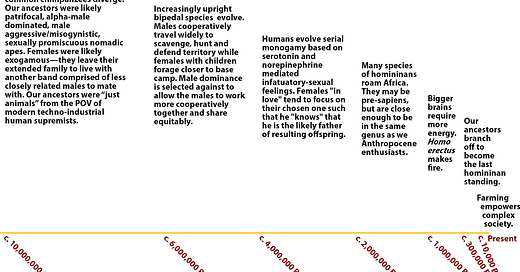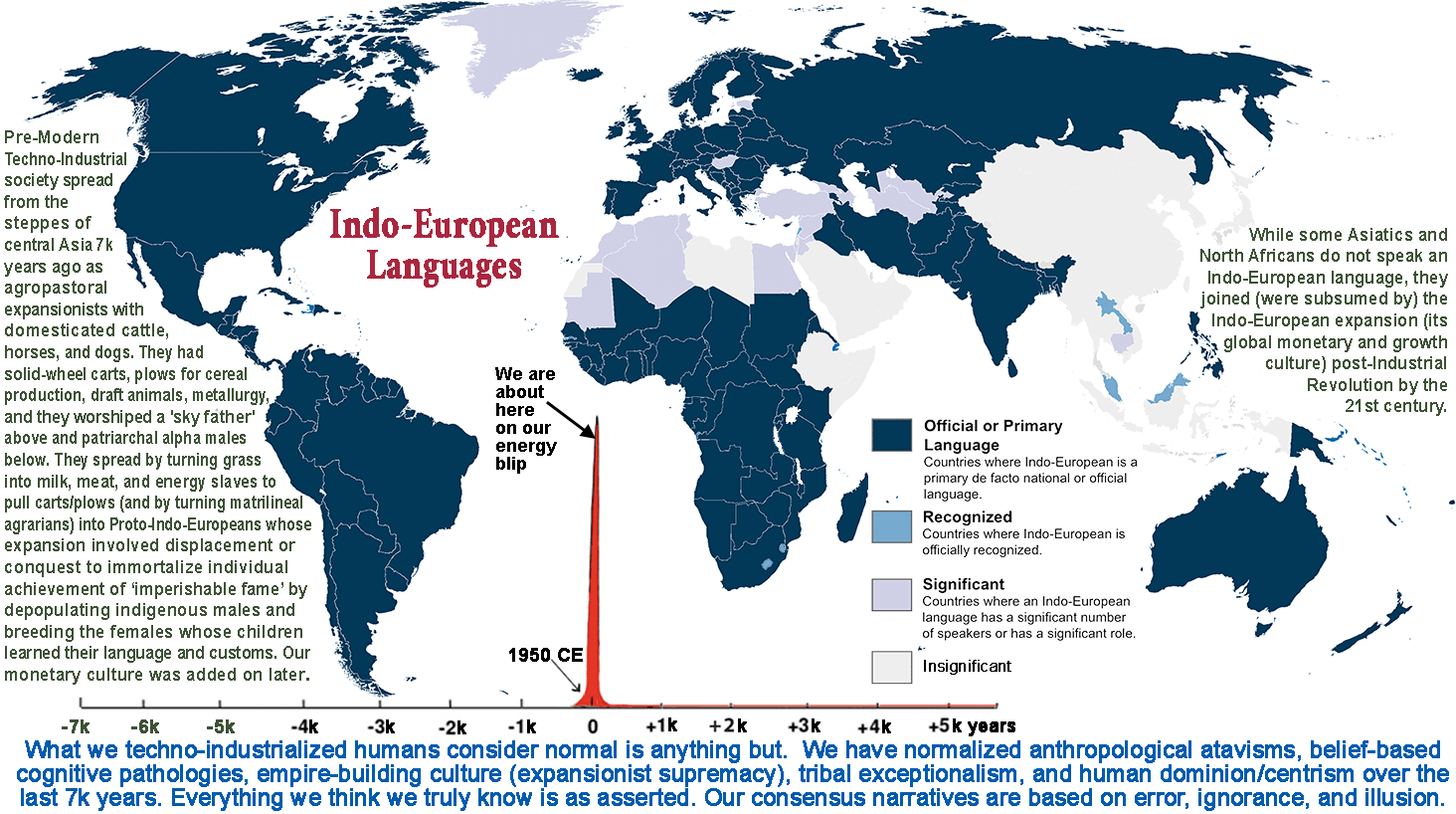The who/where/when of human (homininan species) evolution is the foundation for understanding the context of those humans currently alive as is the natural history of all prior ancestors going back about 4 billion years. Whether the common ancestor of modern humans and common chimps was a human (we are hominins, the third chimpanzee) depends merely on where boundaries of inclusion are defined (at tribe or sub-tribe level). If walking on two legs as an adult is a defining trait, then by ‘human’ we may mean members of the sub-tribe hominina dating back six and some odd million years.
Our current events fixation on homininan happenings is a distraction. Context is needed, and life on Earth is that context. That you know the story that you are Eukarya, empowered by mitochondrial mutualists whose cells number more than the human cells that contain them (about 1.3:1), will be presumed. Tales of mouths and anuses, thanks to having worms for ancestors, should be common knowledge. The ancestor’s tale up to Orrorin tugenensis must be glossed over but remains as the context for the past lives of humans.
10,000,000 BP: The forest dwelling common ancestors of humans and common chimpanzees may have had more in common with the forest dwelling chimps than the bipeds that became adapted to the open savanna, hence behaviors, natural and normal in our last common ancestor persisted as atavisms until selected for during the recent rapid expansion of one form of human within and out of Africa.
6,000,000 BP: Homininans speciate into multiple forms. Male dominance is selected against to allow the males, who sometimes bring home the bacon (central place provisioning), to work more cooperatively together. Women mostly gather, and both are able to walk and carry food, form camps occupied for a few weeks. Grandparents watch over younguns as their mothers forage and fathers hunt/scavenge, selecting for a longer homininan lifespan.
4,000,000 BP: Humans evolve serial monogamy based on infatuatory-sexual feelings that enable females "in love" to focus on their chosen one such that he "knows" that he is the likely father of resulting offspring and that preferential food (especially meat) gifts he bestows upon his true love, before birth and while nursing his likely child, are appropriate—have an evolutionary payoff. When the child is weaned after a few years, it is largely independent, without need of frequent parental care. When the mother is fertile again post-lactation, she may choose a different mate. Romance-based serial pair-bonds are programmed to end within a few years (2-4 years per Helen Fisher’s research).
2,000,000 BP: Opportunistic use of fire led to controlled use of exosomatic energy (firemaking) by Homo erectus that allowed them to live at higher elevations and spread by adaptive radiation out of Africa into temperate regions, and cooking meat and tubers increased available food energy and its digestibility. Bigger brains require more energy/time to program—there is more to learn and infants are born increasingly more immature to allow the head to pass through the birth canal. Childhood is extended beyond weaning. A woman may have more than one dependent offspring at a time and male support is valued as it may make the difference. Having multiple fathers of multiple dependent offspring doesn't work well. Pair bonding evolves to last more than two to four years based on oxytocin and vasopressin mediated feelings of commitment to allow for long-term monogamy, but the infatuatory-sexual propensity remains as does the promiscuous pattern that preceded the romantic infatuatory-sexual adaptation favoring serial monogamy.
1,000,000 BP: Old patterns (genetic/memetic) are not erased before being overlaid with more adaptive patterns, leaving the atavistic patterns to remain. Among the Hadza today, murder (rare but happens) typically involves males, one seeking to gain sexual access to another man’s wife who opposes his access, which sometimes works for seduced and seducer, hence the persistence of the pattern (and response), but pair bonding is the norm (what is selected for, not good or bad, but what works). Unlike modern humans, people live in small groups of trusted with their life others not seeking to conquer other bands.
375,000 BP: Human lifespan, extended to allow for grandparents to help with child rearing, freeing the younger mothers to roam farther in gathering foods without children too young to keep up. They can gather more food allowing them to feed their parents and extended family too. Grandfathers teach their grandsons to hunt small game and make tools. Women supply most of the food. Men bring home meat (sometimes). The social order is matrifocal, matrilineal, and matrilocal. Mythology emphasizes the Great Mother metaphor as in Gaia, Mother Nature, and Mother Earth. Males tend to be exogamous, going to live with their wife's band—a small nomadic group of typically 20-50 people including grandparents and children. The bands of related women/men are on friendly terms most of the time except possibly during periods of extreme scarcity. Human evolution selects for egalitarian tendencies that favor the gifting economy. Patriarchal alpha male inclinations among men remain but are moderated by cultural egalitarian norms that women favor.
75,000 BP: A founding population (<150) emerged, perhaps on the southern tip of Africa where shellfish beds supported potentially larger than band-sized communities in permanent settlements. The genes of modern humans tell a story of rapid expansion of the population within Africa over a 15k-20k year period followed by an out of Africa expansion into Eurasia and the Americas, climaxing with the taking of Zealandia 750 years ago (with island-wide megafauna extinction). Genetically, the only pre-expansionist humans to survive are within Africa, the Pygmy, San, Sandawe, and Hadza, among whom only some San and Hadza retain a mostly intact culture and genome. All other humans on the planet, the 99.99987%, are genetically and culturally closely related (lacking in variation).
60,000 to 55,000 BP: Multiple groups of a single form of human crossed the Red Sea and/or via the Levant to disperse globally, becoming the ancestors of all non Africans other than such Neanderthals, Denisovans, and as yet unidentified humans as they interbred with and displaced. Homo sapiens left Africa over 1,000,000 years ago and were living out of Africa when the single group we descended from came and 'displaced' them, interbreeding with some, but we non Africans descend only from those who made them go away however that may be imagined to have happened. One group rapidly crossed southern Asia to New Guinea and Australia. Others traveled north to Eurasia via the Middle East about 45,000 BP, spreading throughout Western Europe as hunter-gathers (WEH) about 43,000 BP. This expansion event was the first, followed by a second global expansion of Indo-Europeans and their language and culture 7,000 BP.
Technology empowered humans, prior to evolving self-limiting controls, face extinction. Significant empowerment of an animal by technology began with fire making homininans.
Homininans, as K-selected (live within limits) animals, must persist or go extinct, and using fire maximally for short-term self-interest (e.g. to kill all game in a forested box canyon for one feast) would be selected against. Nomad foragers using fire to diversify a biome and prevent large-scale conflagrations by naturally occurring fires, would be adaptive (maximize empower of the system) and was selected for until modern times when insapient fire starting (arson) became common. Note: our Homo erectus ancestors limited their use of the awesome powers of fire, implying we have the potential to self-limit too.
Within Africa, homininan development of stone weapons was slow enough that prey species were able to adapt, so this technology did not lead to extensive megafauna extinctions until humans went out of Africa and developed advanced technology (e.g. atlatl and Clovis point force-multiplier technology). This was humanity's first failure to limit their use of technology to avoid long term harm to themselves and the local ecosystem. Outside of Africa, fauna initially failed to recognize humans as a threat and were killed too easily.
Presuppose that 90% or even 99% of nomadic bands wisely recognized the potential of overhunting naïve prey to extinction, and limited their taking of any species to avoid any noticeable decrease in their population below optimum (e.g. under grazing) as the decades passed.
Oh, but if initially 1% of bands view the animals as a resource for the taking, take them, prosper, and easily support large families. And their offspring do likewise only more efficiently and with greater enthusiasm. Soon, all who are expanding out of Africa are enthusiastic expansionists whose r-culture (short-term quantity maximizer culture) celebrates taking. As one area is depopulated of fauna, no problem, they move on. This short-term expansionism as an invasive species was evidently selected for.
We are their descendants. The pattern worked for millennia, and selected for humans who prospered greatly as an invasive species responding to short-term contingencies of reinforcement (short-term self interest). Eventually an invasive species, however, after overrunning a habitat (e.g. planet Earth) must re-adapt to a steady-state biophysical economy or face local to planetary extinction.
Into a world of nomadic foragers, some came to plant and select for desired traits to domesticate plants (e.g. bottle gourds and food plants), and others domesticated animals as mutualists which allowed the nomadic to settle in one camp and amass possessions far beyond what they could carry. Initially settlements of bands remained band-sized in population, 20 to 50 (range 5-85) trusted others, which was viable, but typically within a few millennia selected for larger populations which selected for hierarchy and the emergence of elites and commoners, the emergence of overcomplex society that selects for growth and expansion (empire building from chiefdom to nation-state), e.g. the global modern techno-industrial form of civilization we are products of, live in, and serve.
About seven thousand years ago a patriarchal culture, dominated by hunters (as on the steppes of Asia there were few plants to gather) domesticated cattle and later horses, developed metallurgy and solid-wheel ox-drawn cart technology the bovines could pull when not pulling plows (horses were hunted for meat and within two thousand years domestic horses were acquired, milked, ridden into battle and used to pull spoke-wheeled war chariots to aid expansion).
The technology of the Proto-Indo-Europeans enabled them to both amass material goods and move them to become nomadic expansionists, expanding into a world of settled agrarians living in band-sized groups (typically not patriarchal) and remaining hunter-gatherers (also not patriarchal except where hunting was the basis of the biophysical economy). The Indo-European expansionists were initially stopped only by earlier high-intensity agriculture-based empire builders (e.g. Mesopotamian, Egyptians, Semites), though their more aggressive culture made steady inroads into these prior cultures even if not enough to replace their language (e.g. the Semitic religion was derived from Zoroastrianism, an Indo-European hierarchical priesthood dominated belief-based religion).
Will modern humans understand their predicament, renormalize... or die?
As the glaciers retreated 19,000 to 14,000 years ago, a new wave of migrants spread into Europe, and about 9,000 years ago, farmers from northwestern Anatolia moved in to spread while displacing the hunter-gatherers, though rarely interbreeding with them (a matrifocal culture). The third major migration began about 5,000 years ago when Indo-European herders swept in from the steppe north of the Black Sea in what is now Russia.
Those Yamnaya pastoralists herded cattle and sheep, and some rode newly domesticated horses. Unlike the hunter-gatherers and agrarians, they were patriarchal and celebrated conquest which their livestock (especially horses) enabled. Little or no male hunter-gatherer/agrarian DNA survived, achieved by killing males and breeding the women who persisted among the agrarians though their language and culture was largely replaced by the Indo-European invaders.
Joseph Campbell found evidence of a goddess culture in the fragments of pre-Indo-European mythology. Descendants of the original populations served their overlords as a peasant, serf, commoner, or slave class (prey-like population to elite predator-like population). Prior to this, the Indo-European culture was not the norm as it is today worldwide.






